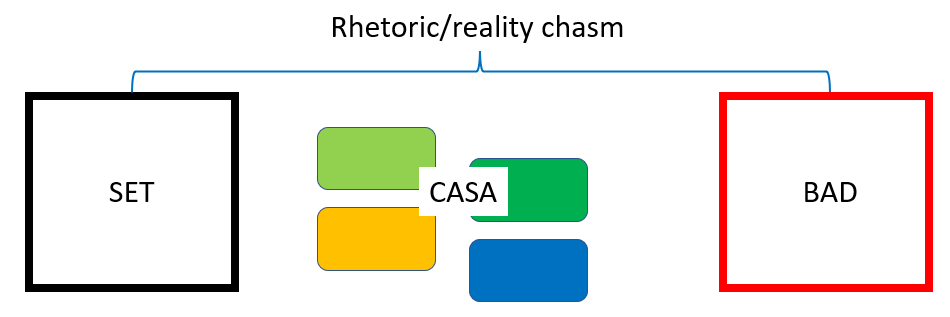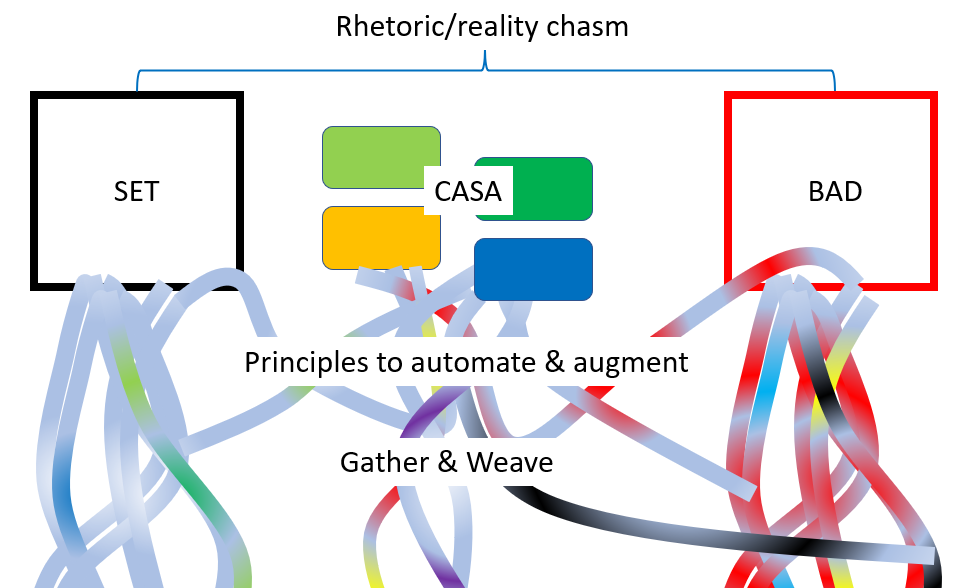The relationships between BAD/SET, CASA, and Gather/Weave#
Over the last 10+ years colleagues and I have been reflecting on experiences trying to stretch the iron-triangle. That work has resulted in three different abstractions/mini-theories:
- The bad/set (Bricolage, Affordances, Distribution / Strategic, Established, Tree-like) framework (Jones & Clark, 2014) and related blog posts
- casa - Context Appropriate Scaffolding Assessmblages (Jones, Lawson, Beer, & Jones, 2018; Jones, 2019) and related blog posts
- The idea of gather/weave/augment (Jones, 2022; Booten, Cook, & Jones, 2023)
The following arises from a realisation that these are related. The following is a first attempt to make that relationship explicit.
Todo
- What about the nature of digital technology stuff post #1
Where and why?#
This all takes place within the challenge of helping higher education institutions (HEI) grow access to higher education while maximising both quality and cost efficiency (i.e. stretch the iron-triangle). The assumption is that design-for-learning is the way to achieve this. Ellis & Goodyear (2019) identify design for learning is key for quality and student satisfaction. Goodyear (2015) argues that seeing teaching as design for learning is an effective way to stretch the iron triangle. Flowing from that is the idea that HEI's should be focused on supporting teaching as design.
Laurillard (2012) mentions the UNESCO Millenium goal of Education for All as exemplifying "the gap between ambition and reality" (p. 226)
How does a HEI support teaching as design to stretch the iron triangle?
Increasingly, I'm wondering
- If these ideas may apply to the broader challenge of digital transformation within similar types of organisations?
- How to focus these principles more on digital-humanism than more corporate worries?
BAD/SET - The current situation#
The bad/SET mindsets describe two (arguably) incommensurable approaches to supporting design for learning/stretch the iron triangle. The SET mindset describes most of how/what institutions do to stretch the iron triangle. The BAD mindset describes how/what individual teachers/teaching do. We argued that there is a chasm between these two approaches and a need to interweave both (Jones & Clark, 2014)
An approach that appears to resonate (duplicate) points from complexity-leadership
CASA - One way to bridge the gap (interweave BAD/SET)#
As the name suggests - contextually-appropriate scaffolding assemblages (CASA) - are collections of practices, processes, technologies etc designed to help support a L&T activities. Collections that follow the CASA design principles are thought to be more effective at interweaving the SET and BAD approaches.
The need for CASA#
Teachers, as much as any other profession, need custom-built digital tools to help them with their ever more complex working environment. They deserve better support from digital technology. And it could make the critical difference to changing what they are able to do with their students. (Laurillard, 2012, p. 222)
Gathering, weaving and epistemic fluency#
Conceptualising teaching as design-for-learning has been positioned as an effective way of dealing with the iron triangle dilemma (Goodyear, 2015). To effectively engage in teaching as design teacher-designers "need to be able to draw together the right set of tools, methods, ideas, data (design knowledge) for each circumstance, and they also need meta-level, strategic, knowledge that can guide them in deciding what kinds of knowledge, and ways of knowing, are most likely to help with the specific design problem at hand" (Goodyear et al, 2022, p. 459).
Which we've characterised as gathering and weaving. Perhaps positioning this task as the key problem. i.e. why the SET mindset fails to effectively support design for learning. As it simply can't do epistemic fluency.
How to automate/augment gathering and weaving#
The gather/weave/augment idea is based on the observation that design-for-learning needs to draw on expert knowledge from numerous fields, including contextual knowledge. That the core of supporting and doing design-for-learning is sustainably and effectively gathering and weaving disparate strands of knowledge into contextual meaningful designs. As suggested by entangled-pedagogy the ability to orchestrate these disparate strands is a key enabler.
Our recent work (Jones, 2022; Booten et al, 2023) was driven by the limitations and inefficiencies of current practices for gathering and weaving. Limitations that arguably arise because of the limitations of the BAD and SET mindsets. A failure to effectively interweave those mindsets. The most obvious symptom of this failed interweaving was the failure to effectively leverage digital technologies to automate and augment/amplify the necessary gathering and weaving. Leading us to develop a nascent set of principles for doing just that.
Technology as orchestration of phenomena#
All this links to the question of technology and digital technology. What is technology?
Arthur (2009) offers
the orchestration of phenomena for some purpose
Orchestration is gathering and weaving, that's what we're talking about above.
But what about purpose? Whose purpose? What purpose? This is a link to democratisation.
What about phenomena, well phenomena is both natural phenomena and other technologies - other orchestrations.
How can computing help with this? Help redefine this? Help democratise this? This is my interest.
Nature of Digital Technology#
Yoo et al (2012) identified two fundamental properties of digital technology
- data homgenisation - all data is represented in binary.
- reprogrammability - algorithms are also represented in binary and those algorithms can be changed.
While that is true at the fundamental level as per Arthur and Dron those 0s and 1s become assembled/orchestrated into more complex phenomena/technologies. Layering on more connections and dependencies that impact these two fundamental properties in response to a specific purpose.
References#
Arthur, W. B. (2009). The Nature of Technology: What it is and how it evolves. Free Press.
Ellis, R. A., & Goodyear, P. (2019). The Education Ecology of Universities: Integrating Learning, Strategy and the Academy. Routledge.
Jones, D., Lawson, C., Beer, C., & Jones, H. (2018). Context-Appropriate Scaffolding Assemblages: A generative learning analytics platform for end-user development and participatory design. Companion sProceedings of the 8th International Conference on Learning Analytics and Knowledge.
Goodyear, P. (2015). Teaching As Design. HERDSA Review of Higher Education, 2, 27--50.
Laurillard, D. (2012). Teaching as a Design Science: Building Pedagogical Patterns for Learning and Technology. Routledge.
Yoo, Y., Boland, R. J., Lyytinen, K., & Majchrzak, A. (2012). Organizing for Innovation in the Digitized World. Organization Science, 23(5), 1398--1408.


